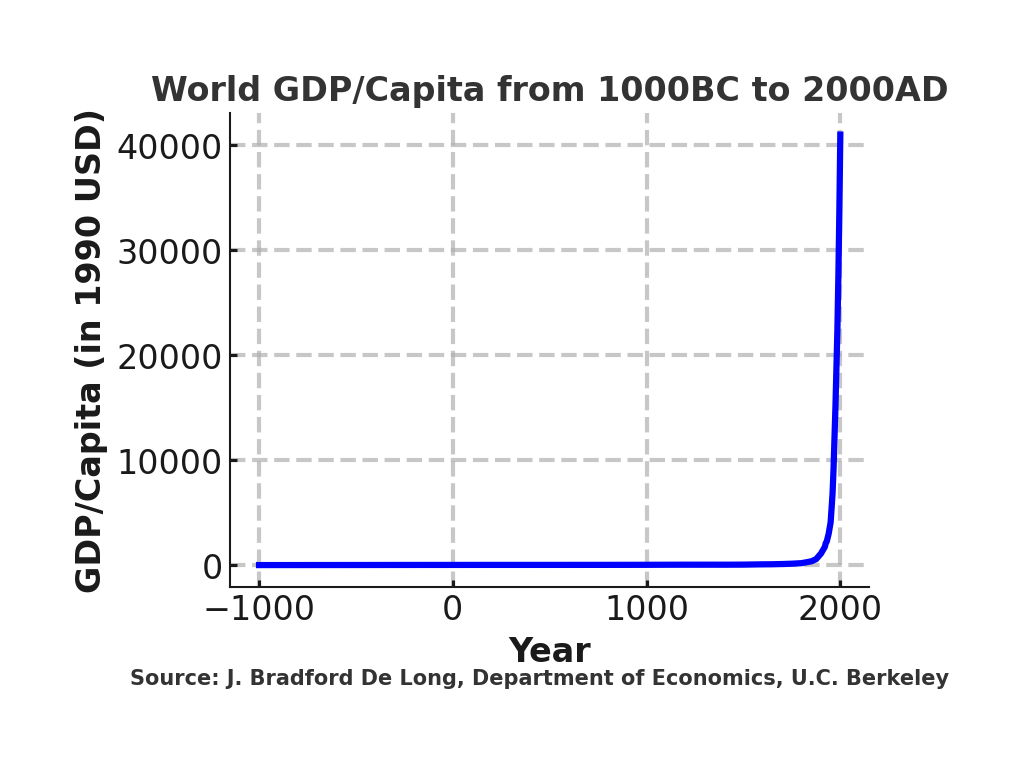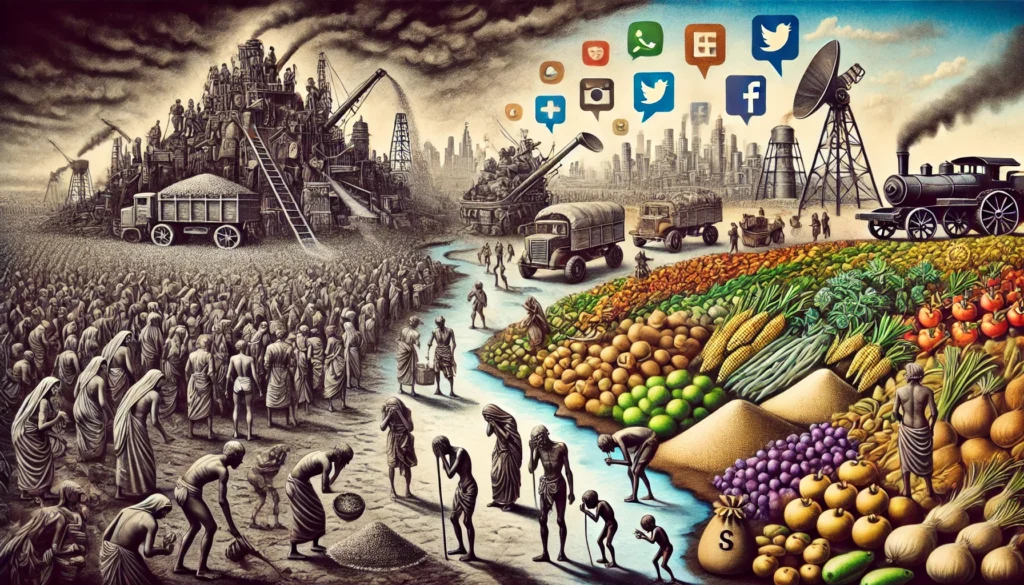Chasing More: The Paradox of Abundance and the Search for Fulfillment
The Bengal Famine of 1943 stands as one of the most tragic and harrowing episodes in modern history. Under British colonial rule in India, Bengal was ravaged by famine, leading to the deaths of an estimated 2.1 to 3 million people. Famines have struck civilizations throughout history, with records dating back to 441 BC in Rome, highlighting the harsh reality of scarcity for basic necessities like food and water. As time progressed, advances in technology and industrialization significantly reduced the threat of famine, but in doing so, a new challenge emerged: a world of abundance that poses its own unique risks.
From Scarcity to Abundance: The Cost of Progress
Over the years crop diversification, better agricultural machinery, food processing and storage, and enhanced irrigation technologies have revolutionized food production. The image below demonstrates how the world GDP, and hence wealth has progressed over the years. The Industrial Revolution not only transformed food production but also enabled the mass extraction of resources, driving humanity toward unprecedented growth and increasing needs.

Yet, this progress came at a price. Desires transformed into wants, and wants morphed into ever-growing needs. The scientific and industrial revolutions, while fueling development, have propelled humanity into an endless race for advancement, often obscuring the true destination. Those who once mastered the art of surviving in times of scarcity now find themselves ill-equipped to navigate an era defined by excess.
The Age of Abundance: A Double-Edged Sword
There was a time when scarcity dominated, and every resource was a treasured possession. Even the smallest of these “precious” items brought joy and deep satisfaction. Today, however, we live in a world overflowing with abundance—what was once rare is now easily accessible. But has this abundance become a blessing, or has it turned into a curse?
Consider sugar, for example. Once a luxury reserved for the wealthy, it’s now found in nearly every food and drink we consume. Its prevalence has grown to the point where even a single serving of soda is offered in XL sizes, often containing up to 100g of sugar—well beyond the recommended daily intake of 27g. In the modern era, there is significant outrage over the over-exploitation of the earth’s natural resources, accompanied by a fear of depletion. Yet the impact of over-consumption is often overlooked. According to the Centers for Disease Control and Prevention (CDC), an estimated 38.4 million people in the USA had diabetes in 2021. Sugar is just one instance of this “problem of plenty”—the excess extends far beyond it.
The Social and Emotional Consequences of Excess
The “problem of plenty” seeps into the emotional and social dimensions of human life as well. In the past, the average person’s world was small, limited to interactions within a community of perhaps 50 people. But with modern transportation and the rise of social media, the floodgates of communication have opened, exposing us to limitless audiences.
Once accustomed to quieter, more intimate circles, people now find themselves constantly in the spotlight. This over-stimulation leads to heightened anxiety and even panic attacks. We’ve reached a point where experiences often feel incomplete or insignificant unless they’re shared on social media—almost as if, without public validation, they never happened at all.
The Burden of Modern Stress
Stress, once a vital response that sharpened instincts and heightened focus during ancient hunts, has now become a constant companion in modern life. What was once an occasional and beneficial reaction is now triggered by even the simplest events, such as receiving an email. Today, stress and anxiety are as prevalent as the overwhelming tasks we face, infiltrating even the most mundane aspects of our daily routines. A study conducted found that 55% of adults in the U.S. reported experiencing frequent stress in their daily lives.
Our homes have grown larger but often feel emptier. We’ve become wealthier, yet we may find ourselves smiling less frequently. Our plates are fuller, but our steps are fewer. We accumulate more possessions but often experience diminished contentment. While technology connects us to the world, face-to-face conversations have become increasingly rare. In this age of abundance, it seems we have gained much, yet we have lost touch with the simple joys that once enriched our lives. As stress levels rise and contentment declines, it becomes clear that the key to finding peace in this age of plenty lies in rewiring how we think about our needs.
Rewiring for Contentment: Navigating a World of Plenty
The scientific revolution has armed humanity with immense knowledge, but it also presents a new challenge: rewiring minds conditioned by millennia of scarcity. Our ancestors’ survival instincts drove them to hoard and accumulate, habits that no longer serve us in this age of plenty. In fact, the very instincts that once kept us alive now often lead to overindulgence and dissatisfaction. More does not always mean merry!
To find balance in this age of abundance, we must learn to differentiate between genuine needs, a few select wants, and excess desires. Cultivating gratitude for what we already have can foster contentment and shift the focus from accumulation to fulfillment. For example, eating until 80% full, a practice known as “Hara Hachi Bu” in Okinawan culture, can promote both physical and mental well-being. Similarly, understanding that a car is a tool for transportation—not a symbol of status—can help reduce the compulsion to own more than is necessary.
Conclusion: Finding Joy Beyond Excess
In our modern world, where abundance is the norm for many, the challenge lies in resisting the urge to accumulate more and more. True happiness does not come from possessing more but from making mindful choices that align with our deeper values. By discerning between what truly enriches our lives and what merely adds clutter, we can break free from the cycle of excess and rediscover the simple joys that once defined human existence.
As we endlessly chase more, it’s worth asking—are we accumulating what truly matters, or are we caught in a cycle that never leads to fulfillment?
For your reading:
- The Philosophy of Enough: The Whole Life Challenge Guide to Increased Happiness
- The philosophy of enough: how to find fulfillment in a world of excess
- The Abundance of Joy: An Epicurean Approach to Enjoying What We Have
- Estimates of World GDP, One Million B.C. –Present
Writer: Ankita Pujar,
Editor: Dr. Robin Garg


